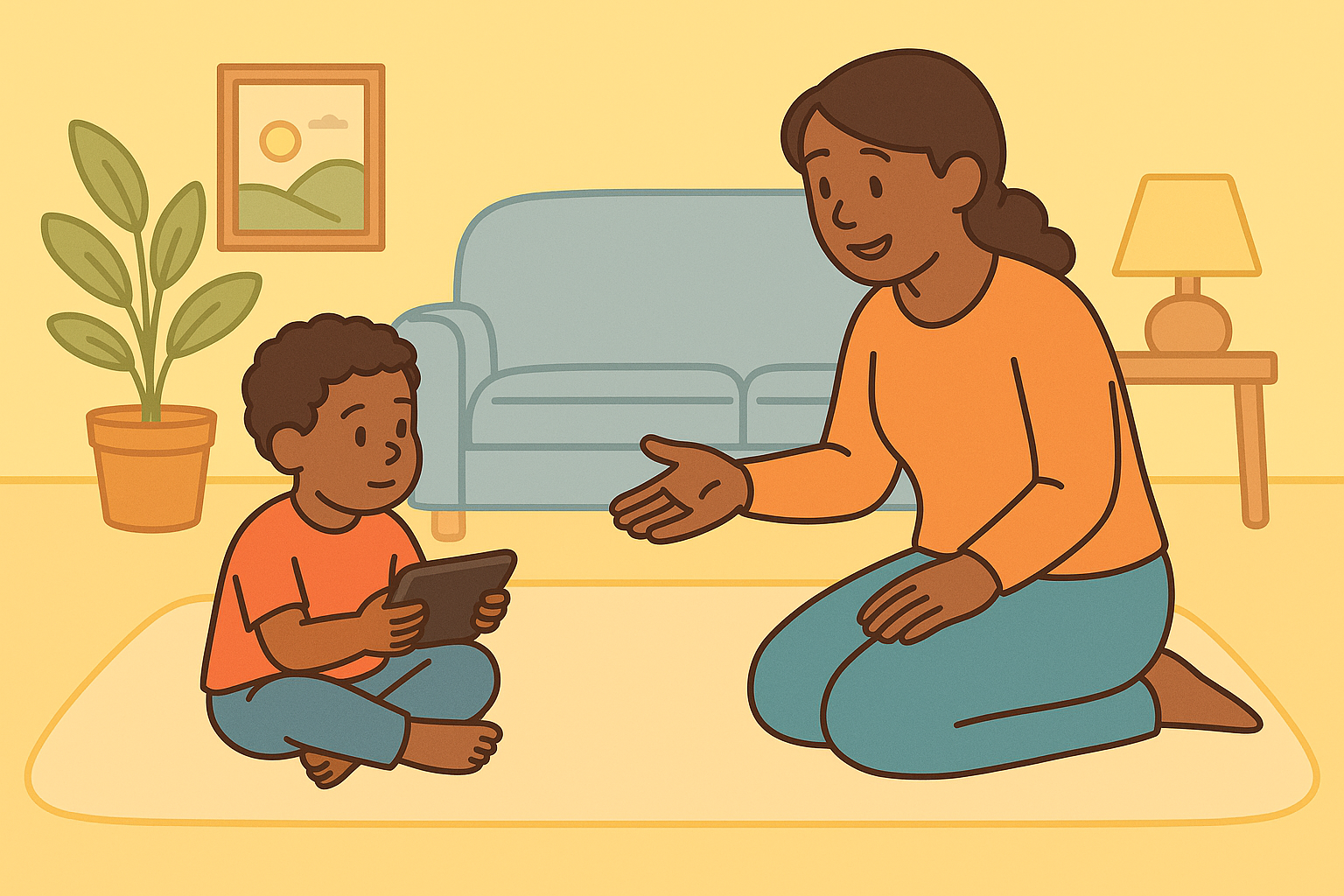Tech Boundaries That Stick: Setting Limits Without Meltdowns
Tech Boundaries That Stick: Setting Limits Without Meltdowns
Few things test a parent’s patience like saying, “Okay, time to turn it off,” and watching the meltdown begin.
The truth is — tech limits aren’t just hard for kids. They’re hard for brains. Digital play triggers excitement, reward, and flow — turning it off feels like hitting a wall.
But boundaries don’t have to mean battles. With the right balance of structure, communication, and empathy, you can teach your child to self-regulate, not just comply.
Let’s explore how to make screen time boundaries that stick — and how to say “time’s up” without tears.
Why Boundaries Matter
Children thrive when they know what to expect. Clear, consistent tech limits help them develop:
Emotional regulation
Patience and flexibility
Healthier focus and sleep
Without boundaries, devices take over those roles — setting rhythms for attention and reward that the brain isn’t built to manage alone.
💡 Fuzzigram tip: Boundaries aren’t punishment — they’re protection.
Step 1: Understand the Science Behind the Struggle
When you tell a child it’s time to stop watching or playing, their brain experiences a dopamine drop — the “fun chemical” that rewards engagement.
That drop can feel like frustration, sadness, or anger. The meltdown isn’t defiance — it’s regulation in progress.
💡 Fuzzigram tip: Empathy calms brains faster than logic. “I know it’s hard to stop when you’re having fun” works better than “You’ve had enough.”
You might also like The Science of Screen Time: How Devices Affect Kids’ Brains.
Step 2: Use Predictable Cues
The surprise “Turn it off now!” almost always backfires. Predictability creates security — so make transitions visible and consistent.
Try:
A five-minute warning timer or visual countdown
A song cue (like “cleanup” music)
Verbal pacing: “Two more minutes — finish this level.”
💡 Fuzzigram tip: Kids handle transitions better when they can see them coming.
Step 3: Replace, Don’t Just Remove
Going from “full fun” to “nothing” feels jarring. Offer a soft landing — something engaging, not empty.
Transition ideas:
Move from tablet → outdoor activity
Move from video → real-life version (“Let’s draw that animal we saw!”)
Move from game → snack or storytime
💡 Fuzzigram tip: Kids can shift focus more easily when the next activity meets a similar emotional need (curiosity, creativity, or comfort).
Step 4: Create Clear Rules Together
When kids help set limits, they resist less. Hold a quick family chat:
Ask:
“What’s a good screen limit that feels fair?”
“What should happen if we forget to stop?”
Then agree on 3–4 clear, written rules. Keep them posted where everyone can see.
💡 Fuzzigram tip: Collaboration turns rules into agreements.
You might also like How to Create a Family Media Plan That Actually Works.
Step 5: Match Limits to Age and Energy
Younger children often need shorter, more frequent breaks. Older kids may benefit from longer blocks of focused use — followed by outdoor time or creative play.
Example:
Ages 3–5 → 20-minute sessions with breaks
Ages 6–10 → 45–60-minute chunks
Ages 11+ → agreed-on windows, not free-for-all
💡 Fuzzigram tip: A “tech rhythm” beats a “tech rule.” Predictability reduces resistance.
Step 6: Model What You Expect
If parents scroll during dinner, kids internalize that tech always takes priority. Show them what healthy breaks look like.
Say:
“I’m putting my phone down now — it’s family time.”
“Let’s both take a break together.”
💡 Fuzzigram tip: Modeling calm withdrawal helps kids mirror self-regulation.
See Digital Role Modeling: How Your Own Habits Shape Theirs.
Step 7: Keep Boundaries Consistent Across Caregivers
Mixed rules (“Grandma lets me!”) create confusion and frustration. Align with all caregivers or co-parents on shared tech boundaries.
💡 Fuzzigram tip: Consistency builds trust — and prevents manipulation through loopholes.
You might also like How to Stay Consistent Between Caregivers and Homes.
Step 8: Use Tech Tools, Not Tension
Use built-in parental features as gentle reminders — not secret traps.
Options:
Apple Screen Time or Google Family Link
Timed shutdowns or “wind down” modes
Apps that prompt screen-free breaks
💡 Fuzzigram tip: Tech tools work best when your child understands why they exist.
Step 9: Expect Some Pushback (and Stay Calm)
Even with perfect boundaries, frustration is normal. When it happens, hold steady.
Try saying:
“I hear you. You wish you could play longer. You can try again tomorrow.”
This acknowledges the emotion while reinforcing the limit.
💡 Fuzzigram tip: Boundaries stick when they’re calm, consistent, and kind.
Step 10: Celebrate Balance
Notice when your child transitions smoothly — even for a few minutes.
“You turned it off right away — that showed great control.”
Positive reinforcement builds motivation and independence.
💡 Fuzzigram tip: Focus on the behavior you want more of, not just what you want to stop.
Boundaries that stick aren’t built through power struggles — they’re built through trust.
When kids know what to expect, when to expect it, and why the rule exists, they stop fighting the boundary and start owning it.
Because at the heart of every healthy tech limit isn’t control — it’s connection.
This content is for educational purposes and is not a substitute for professional medical or psychological advice.
Popular Parenting Articles


